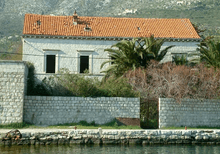Giorgi family
Giorgi
| |
|---|---|
 | |
| Country | |
| Estate(s) | Palazzo Giorgi, Dubrovnik |
| Cadet branches | Bona-Giorgi |


The Giorgi or Zorzi were a noble family of the Republic of Venice and the Republic of Ragusa.[1]:I: 54[2]
History
Tradition links the Zorzi to the origins of the city of Venice. In 1817, Antonio Longo wrote that they came from Moravia and Silesia; entered Italy in 411 AD and took up residence at Pavia; and after the invasion of Attila in 453 AD were among the founders of Venice.[3]
The first documented mention of the family dates from the tenth century: in 964 Gregorio di Andrea de Georgii was bishop of the island of San Pietro di Castello, formerly known as Olivolo, in the Venetian Lagoon.[2][4]
It has been suggested that the Giorgi came to Ragusa either from Rome[5] or from Kotor.[1]:I: 58
The island of Curzola has been a fiefdom of the family since 1254.[6]
The Ragusan branches
Over the centuries, the Giorgi were divided into several branches in Italy and abroad, merging with other noble families of Dubrovnik and continental Europe. A branch of the family joined its name and arms to those of the Bona family, creating a new branch as Bona-Giorgi.[1]:III: 71
The Giorgi were among the important families of the Republic of Ragusa, serving in the 14th and 15th centuries in 6.50% of all major public offices.[7]:51 Between 1440 and 1640 the Giorgi had 109 members of the Great Council, representing 4.95% of the total.[7]:54 In the two hundred years, they also count for 203 senators (6.21%), 163 rectors of the Republic (6.84%),[7]:60 173 representatives in the minor council (6.33%) and 41 guardians of justice (4.99%).
People
Members of the family include:
- Marino di Matteo Zorzi (1231–1312), governor of the Republic of Ragusa, later Doge of Venice[2]
- Niccolò di Francesco Zorzi (15th century), Venetian ambassador to Pope Martin V[2]
- Marco di Bertucci Zorzi (mid-15th century), Venetian military commander and ambassador to France[2]
- Giorgio di Giovanni Zorzi, born 1582, Venetian ambassador to France and Poland[2]
- Pier Antonio Zorzi (1745–1803), 5th Archbishop of Udine, cardinal[2]
The Ragusan poet Ignjat Đurđević (Ignazio Giorgi) did not belong to this family, but to another ennobled a few years before his birth in 1675.[8]:145
Gallery
 |
 |
 |
 |
 |
 |
 |
References
- 1 2 3 Konstantin Jireček (1984–1986) L'eredità di Roma nelle città della Dalmazia durante il medioevo (in Italian). Atti e Memorie della Società dalmata di storia patria, volumes IX, X, XI. Roma: Società Dalmata di Storia Patria.
- 1 2 3 4 5 6 7 Zorzi (in Italian). Enciclopedie online. Rome: Istituto della Enciclopedia Italiana. Accessed February 2017.
- ↑ Antonio Longo (1817). Dell'origine e provenienza in Venezia de' cittadini originarj (in Italian). Venexia: Tipografia Gasali.
- ↑ Mario Brunetti (1937). Zorzi (in Italian). Enciclopedia Italiana. Rome: Istituto della Enciclopedia Italiana. Accessed February 2017.
- ↑ Giorgio Gozzi, La libera e sovrana Repubblica di Ragusa 634-1814, Volpe Editore, Roma 1981
- ↑ Antonio Renato Toniolo, Umberto Nani, B. F. T., Giuseppe Praga, Adolfo Venturi (1931). Dalmazia (in Italian). Enciclopedia Italiana. Rome: Istituto della Enciclopedia Italiana. Accessed May 2017.
- 1 2 3 Zdenko Zlatar (2002). "Huius... est omnis Rei Publicae potestas": Dubrovnik's patrician houses and their participation in power (1440–1640). Dubrovnik Annals (6): 45–65.
- ↑ Šime Ljubić (Simeone Gliubich) (1856). Dizionario biografico degli uomini illustri della Dalmazia (in Italian). Vienna: Rod. Lechner.
Further reading
- Francesco Maria Appendini (1803). Notizie istorico-critiche sulle antichità storia e letteratura de' Ragusei. Ragusa: Dalle stampe di Antonio Martecchini.
- Renzo de 'Vidovic (2004). Albo d'Oro delle famiglie nobili patrizie e illustri nel Regno di Dalmazia. Trieste: Cultural Scientific Foundation Rustia Traine.
- Robin Harris (2006). Dubrovnik: A History. London: Saqi Books.
ISBN 9780863569593.
- translated as: Robin Harris, Alessandro Sfrecola (translator) (2008). Storia e vita di Ragusa – Dubrovnik, la piccola repubblica adriatica. Treviso: Editrice Santi Quaranta. ISBN 9788886496834.